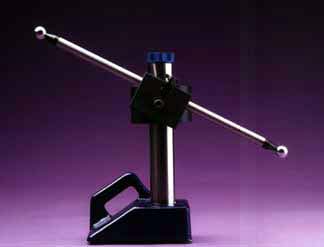Bal-tec™ Home The Triple Cross Tells All
The Triple Cross Tells All
The amazing ability of a Ball Bar (Dumbbell) to evaluate the overall performance of a Coordinate Measuring Machine is based on crossing or reversing the Ball Bar (Dumbbell). This is a form of reversal technology, which in effect is a self checking, natural standard, that requires no actual calibration. In this case, a Ball Bar (Dumbbell) of unknown length can be used to evaluate the performance of the entire C. M. M. system.
A Ball Bar (Dumbbell) is simply two very round spheres of exactly the same diameter that are securely attached to opposite ends of a rather long rigid bar The most complicated errors in a C. M. M. system can be broken down into deviations from perfect movements along the machines three orthogonal axii. Some of these errors may be geometry related errors while others may be scale errors. In addition to basic machine errors the Ball Bar (Dumbbell) will also evaluate effects caused by the environment and even the computer software.


The result of using these simple reversal techniques with the Ball Bar (Dumbbell) set at two opposite angles is to evaluate the overall performance of the measuring machine in minutes. When an inclined Ball Bar (Dumbbell) is placed at a right angle to a machine axis is measured, the probe moves all the way down at one end and then all the way up at the other end. When this angled Ball Bar (Dumbbell) is rotated 180 degrees, the probe moves all the way up and then all the way down. These two movements of the machines axii are just the opposite, so that any squareness errors in the plane at right angles to the Ball Bar (Dumbbell) will be measured as a variation in the lengths of the two Ball Bar measurements. It will measure short in one direction and long in the other.
Pitch, Yaw and Roll which are rotational errors around the linear axii can be evaluated by measuring an angled Ball Bar (Dumbbell), and then reversing it and moving it across to the other side of the axis. When the same procedure is followed in the other two axii, an excellent interim evaluation of the machines overall performance can be made in minutes. In addition, any scale misalignment or reading error will cause the Ball Bar (Dumbbell) to measure a different length along one axis than it does along the second or the third axii To minimize machine geometry errors for these measurements, the Ball Bar (Dumbbell) is usually held horizontal for X and Y axis scales and vertical for the Z axis.
See also, "Accurately Measuring the Ball Center to Ball Center Length of a Ball Bar."
